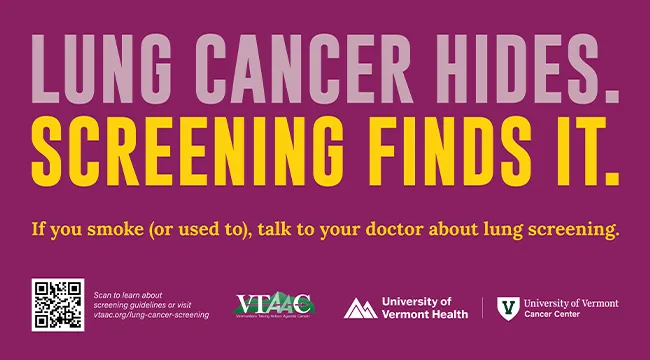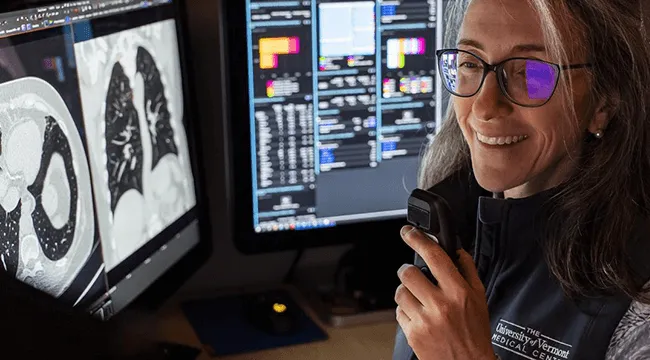Clinicians across Vermont and northern New York hope to expand lung cancer screening efforts this year, with a focus on screening more patients at high risk for lung cancer who aren’t experiencing symptoms.
The region-wide push to expand lung cancer screening is happening during this year’s National Lung Cancer Screening Day, which takes place Saturday, November 8, at participating clinical sites throughout Vermont, northern New York and New Hampshire.
Despite the benefits of lung cancer screening, screening rates remain low across Vermont and northern New York. Just 22.8% of eligible individuals in both states are screened for lung cancer, according to the Centers for Disease Control and Prevention.
The event is supported by UVM Health – University of Vermont Medical Center, the University of Vermont Cancer Center, Vermonters Taking Action Against Cancer (VTAAC), 802Quits, and the American Cancer Society.
To reach more eligible patients, the coalition has expanded the list of participating clinical sites to include:
- Southwestern Vermont Medical Center, Bennington, Vt.
- Dartmouth Cancer Center Bennington
- Dartmouth Cancer Center, Hanover, N.H.
- Northwestern Medical Center, St. Albans, Vt.
- Rutland Regional Medical Center, Rutland, Vt.
- Vermont Diagnostic Imaging, Williston, Vt. (hosting the event on 11/15)
- UVM Cancer Center sites
- UVM Medical Center, Burlington, Vt.
- Central Vermont Medical Center, Berlin, Vt. (hosting the event on 11/7)
- Champlain Valley Physicians Hospital, Plattsburgh, N.Y.
- Elizabethtown Community Hospital – Ticonderoga, Elizabethtown, N.Y.
A coordinated communications campaign focused on lung screening and quitting smoking –which is still the cause of about 80% of lung cancer cases and deaths – will continue throughout November, which is National Lung Cancer Awareness Month.
Cancer survivors say screening saved their lives
Gretchen Bailey of Panton, Vt., never imagined she could have lung cancer. She quit smoking years ago and felt perfectly healthy. But a routine lung cancer screening recommended by her doctor told a different story. After being diagnosed with Stage 1 lung cancer in 2021, Bailey underwent surgery at UVM Cancer Center to remove the lower half of her left lung. Today, she’s cancer-free and living her life to the fullest.
“If I hadn't had that screening, I could have died of lung cancer,” she said.
Sharon O’Connor of Mineville, New York, said routine lung cancer screening has been an important part of her medical plan for years.
“It wasn’t if I was going to get cancer, it was when – and what kind,” she said.
A longtime smoker with a strong family history of various cancers, O’Connor credits routine lung screening for catching her cancer early. A low dose computer tomography (LDCT) scan last summer helped jump-start early treatment, and she is now doing well.
“I’ve always been vigilant about yearly checkups. If something didn’t look right, my doctor and I wanted to know why,” O’Connor said.
How screening saves lives
Lung cancer is the leading cause of cancer death in the United States for both men and women. But early detection through LDCT scans can reduce the risk of dying from lung cancer by 20% among high-risk individuals.
When caught early, lung cancer has a 65% five-year survival rate. When found late – after it has spread to other areas of the body – the survival rate drops to just 9%, according to the American Cancer Society.
“Lung screening is vitally important for people at risk and can save lives,” said Beth Zigmund, MD, director of UVM Cancer Center’s Lung Screening Program. “If we catch lung cancer when it's small, we're looking at easier treatment, lower costs, and better outcomes. Even if the cancer is a later stage, the sooner we know about it, the more we can help.”
Between November 2019 and September 2025, 6,461 people were screened at UVM Cancer Center sites. Of those, 54 were diagnosed with lung cancer, and nearly 7 out of 10 (or 68%) of those cases were caught at an early stage. Only 2% were diagnosed at the most advanced stage, when the cancer is larger and much less likely to be cured.
That’s a stark contrast to early detection at the national level, where just 3 of 10 lung cancers are caught early. Catching people’s cancer at an early stage leads to better outcomes.
“We want to do as much as we can to diagnose people years before their cancer gets to the point where we can’t fix it. A routine screening gives us that chance. It’s simple, it’s fast, and it’s saving lives,” said William Staub, PA-C, a physician assistant at UVM Health – Champlain Valley Physicians Hospital.
Those interested in screening should meet with their primary care provider and engage in a joint discussion called shared decision-making. A primary care provider can make a referral for a lung screening.
Cost of late detection
Lung cancer accounts for 13% of new cancer cases in Vermont each year, yet causes 22% of all cancer deaths, making it the state’s leading cause of cancer mortality, according to the American Cancer Society Facts and Figures Report for 2025. In northern New York, it accounts for 25.8% of cancer deaths.
Bailey understands why some might hesitate when it comes to screening.
“I think the scary part for many people is not the screening itself, but finding out what the results are,” she said.
For Bailey, finding out the results yielded many benefits. Early detection enabled a smoother treatment process and quick recovery: she was back on her feet within six weeks.
“My breathing improved, and my pulmonary tests were better than they were before I had my lower lobe removed,” she said. “Lung screening gave me extra quality time doing the things I love and being with the people I love.”
University of Vermont Health
40 IDX Drive
South Burlington, VT 05403
###
About University of Vermont Cancer Center
University of Vermont Cancer Center is Vermont’s only not-for-profit comprehensive clinical and research cancer center with treatment locations in Burlington, Berlin, Middlebury, Elizabethtown, Plattsburgh and Malone. Founded in 1974 and located within the University of Vermont Larner College of Medicine, the Cancer Center draws on the expertise of more than 250 research and clinical members. The Cancer Center works in clinical partnership with University of Vermont Health, a rural academic health system serving Vermont and northern New York. Together, we work to reduce the burden of cancer across Vermont, northeastern New York and northern New England through research, outstanding clinical care, community outreach, and education. For more information, visit www.vermontcancer.org.
About Vermonters Taking Action Against Cancer (VTAAC)
VTAAC is Vermont’s statewide cancer coalition. VTAAC is responsible for putting the Vermont Cancer Plan into action by preventing overlap and directing resources to where they matter most in our state. Activities are focused on reaching our ultimate goal: reducing the burden of cancer for all Vermonters. VTAAC is a growing network of groups and individuals that speaks with one voice about reducing cancer risk, detecting cancers earlier, creating better access to quality cancer treatment, and improving the quality of life for cancer survivors. To find out more, visit: https://vtaac.org/
About University of Vermont Health
University of Vermont Health is a rural academic health system with more than 100 years of service to small towns and cities across Vermont and northern New York. We are deeply committed to reimagining rural health in ways that will benefit our communities for generations to come and keep exceptional care close to home. Our system includes an academic medical center, two community hospitals, three critical access hospitals, a children’s hospital, a cancer center, a multispecialty medical group, 154 outpatient sites and care beyond the hospital through home health, hospice care, four skilled nursing facilities and other support services. Our care is informed by an essential partnership with University of Vermont’s The Robert Larner, M.D. College of Medicine and College of Nursing and Health Sciences. Together, as a health system serving a rural area, we are tackling health care’s biggest challenges — supporting the communities we serve and investing in our employees by addressing housing affordability, quality childcare and professional development needs. To learn more, visit us at www.uvmhealth.org
About 802Quits
802Quits is an evidence-based tobacco and nicotine treatment program accessible by phone, online, or text for Vermont residents wanting support in their quit journey. The state’s quitline, implemented by the Vermont Department of Health, follows all Centers for Disease Control and Prevention and North American Quitline Consortium protocols, providing support including over-the-phone cessation counseling with a quitline coach, printed materials, text messaging, access to online cessation information, quit progress tracking tools, and peer support, depending on enrollment type. Nicotine replacement therapy, or NRT, is the most commonly used family of quit smoking medication, including patches, gum, and lozenges, and is provided to enrollees free of charge. The quitline also provides tailored protocols and incentives for priority populations, including Medicaid members, uninsured adults, adults who use menthol products, adults with mental health conditions, pregnant and post-partum adults, and members of the Abenaki or other American Indian or Alaska Native tribes. 802Quits is available free of charge to adult enrollees 18 and older, with services from My Life, My Quit available for youth aged 14 – 17 years. Consistent funding is a key consideration for the effectiveness of state quitlines to ensure this evidence-based service is available for all.



